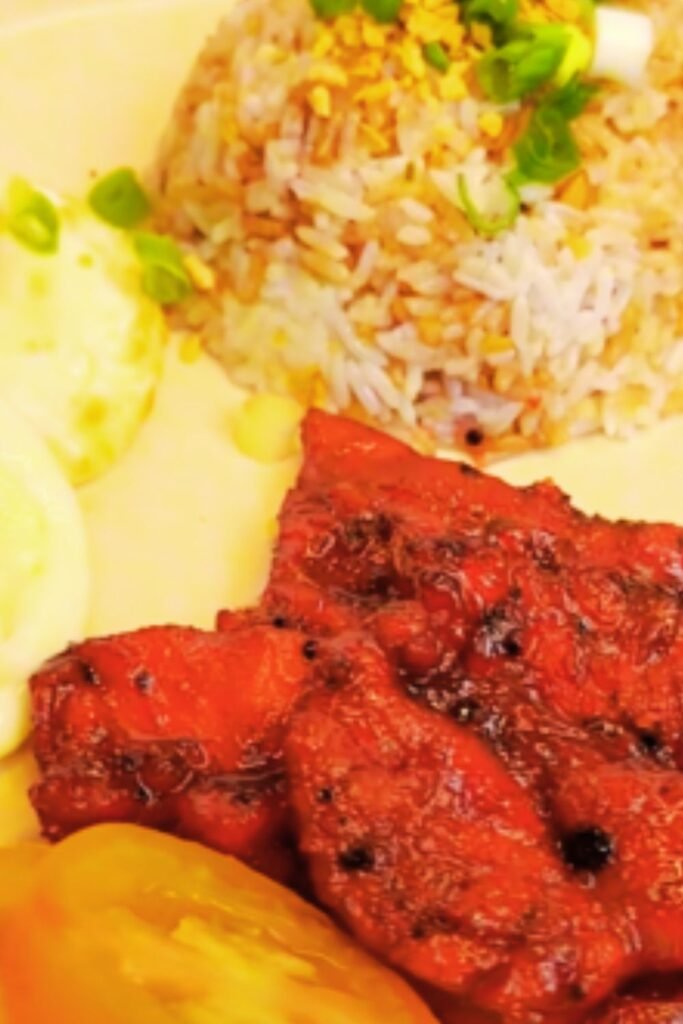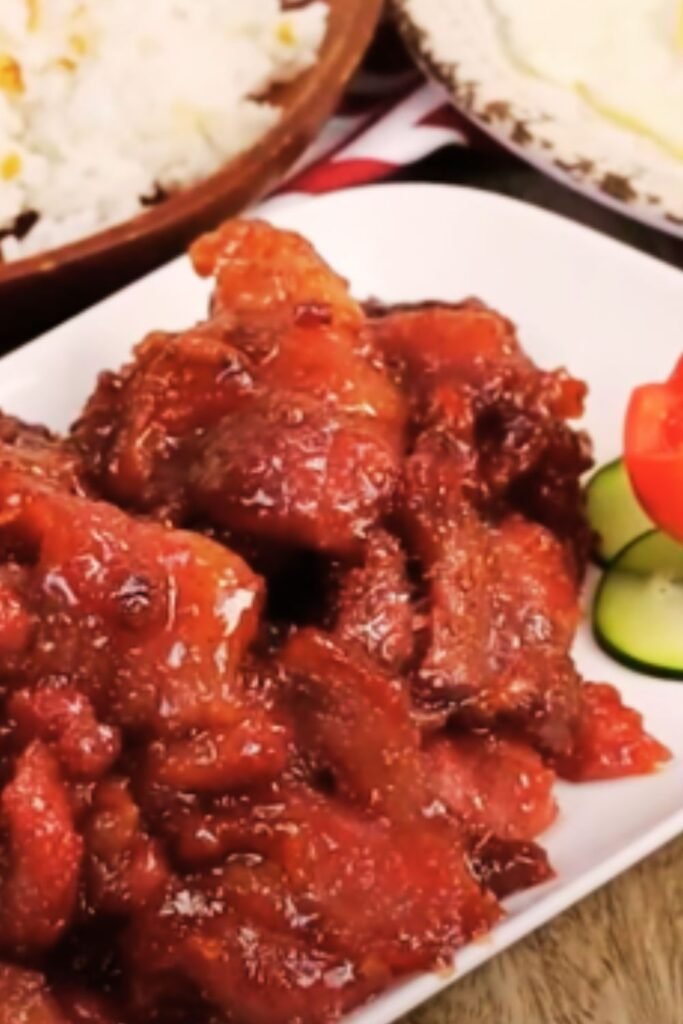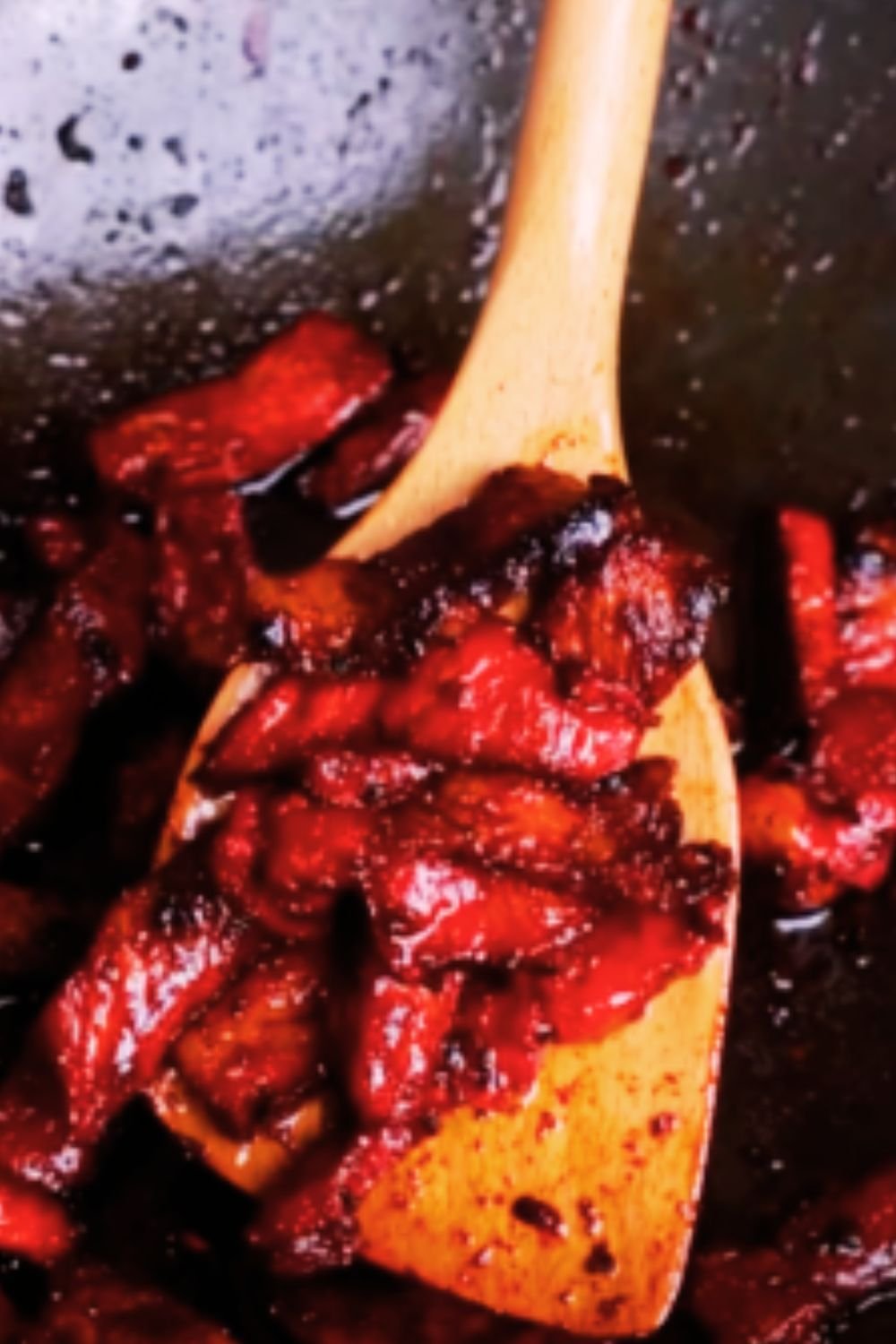Introduction
When I think of Filipino breakfast, one dish that always brings a smile to my face is Pork Tocino. This sweet cured pork holds a special place in Filipino cuisine, particularly as a star component of the famous “tosilog” breakfast combo (tocino, sinangag or garlic fried rice, and itlog or egg). My family has been making tocino for generations, and today I’m excited to share our authentic recipe with you.
Tocino, derived from the Spanish word for bacon, has been adapted and transformed in Filipino kitchens to create something uniquely our own. Unlike its Spanish counterpart, Filipino tocino is distinctively sweet with hints of saltiness, creating that perfect flavor balance that makes it irresistible. The beautiful reddish-pink color and caramelized edges when cooked make it as visually appealing as it is delicious.
In my years of preparing this dish, I’ve perfected the technique of balancing the marinade ingredients to ensure that tender, juicy texture and that signature sweet-savory flavor profile that makes tocino so beloved. Whether you’re a Filipino missing the taste of home or someone looking to explore Filipino cuisine, this recipe will guide you through creating authentic pork tocino right in your kitchen.
What is Pork Tocino?
Before diving into the recipe, let me explain what makes pork tocino special. This Filipino breakfast staple consists of thinly sliced pork shoulder (or sometimes pork belly) that’s been cured in a sweet marinade, typically containing sugar, salt, and various seasonings. The curing process traditionally took several days, though modern versions (like the one I’ll share) have shortened this considerably.
Tocino is characterized by:
- A distinctively sweet flavor profile with subtle saltiness
- A reddish-pink appearance (traditionally from saltpeter, but now often from food coloring or annatto)
- Tender, juicy meat that caramelizes beautifully when cooked
The dish represents the Spanish influence on Filipino cuisine, adapted over centuries to suit local tastes and ingredient availability. While traditional tocino preparation involved lengthy curing with saltpeter (potassium nitrate), my recipe offers a simpler, more accessible approach without sacrificing authenticity or flavor.
Ingredients and Substitutions
For my tried-and-true pork tocino recipe, you’ll need:
- 1 kg (2.2 lbs) pork shoulder (kasim) or pork belly, sliced thinly
- 1 cup granulated white sugar
- 2 tablespoons salt
- 2 tablespoons garlic powder
- 1 tablespoon ground black pepper
- ¼ cup pineapple juice (for tenderizing)
- 3 tablespoons soy sauce
- 2 tablespoons annatto powder or red food coloring (optional, for color)
- ½ cup ketchup
- 1 tablespoon vinegar
Possible Substitutions
I understand that some ingredients might not be readily available, so here are some substitutions I’ve tested:
| Original Ingredient | Possible Substitution | Notes |
|---|---|---|
| Pork shoulder/belly | Pork loin | Less fat content; will be less juicy but healthier |
| Pineapple juice | Grated green papaya | Traditional tenderizing agent in Filipino cooking |
| Annatto powder | Beet juice | Natural coloring alternative |
| White sugar | Brown sugar | Adds deeper molasses notes |
| Ketchup | Tomato paste + sugar | Adjust to taste |
| Garlic powder | Fresh minced garlic | Use 4-5 cloves, finely minced |

Equipment Needed
To prepare this recipe, I recommend having:
- Sharp knife for slicing pork (if buying whole cuts)
- Large mixing bowl (glass or stainless steel preferred)
- Measuring cups and spoons
- Food-safe gloves (optional but recommended)
- Resealable plastic bags or airtight containers for marinating
- Heavy-bottomed skillet or frying pan
- Spatula for turning the meat
- Meat thermometer (optional but helpful)
Step-by-Step Instructions
Preparing the Meat
- If you’re starting with whole pork cuts, partially freeze the meat for about 1-2 hours until firm but not solid. This makes slicing much easier.
- Slice the pork into thin pieces, about ¼ inch thick. For an authentic tocino texture, aim for pieces that are thin enough to cook quickly but thick enough to remain juicy.
- If using pre-sliced meat, check for any excess fat or gristle and trim as desired. I personally leave a bit of fat for flavor and juiciness.
Making the Marinade
- In a large mixing bowl, combine sugar, salt, garlic powder, and black pepper. Mix thoroughly.
- Add pineapple juice, soy sauce, annatto powder (or food coloring if using), ketchup, and vinegar. Stir until the sugar is mostly dissolved.
- Taste the marinade and adjust seasoning as needed. It should be predominantly sweet with noticeable saltiness and a hint of acidity.
Marinating Process
- Add the sliced pork to the marinade. Using gloved hands, massage the marinade into the meat thoroughly to ensure even coating.
- Transfer the meat and marinade to resealable plastic bags or airtight containers.
- Remove as much air as possible if using bags, then seal tightly.
- Place in the refrigerator to marinate for at least 24 hours. For best results, I recommend 48-72 hours, turning the bags or stirring the meat once daily to ensure even marinade distribution.

Cooking Methods
Traditional Pan-Fry Method:
- Remove the marinated meat from the refrigerator about 30 minutes before cooking to take the chill off.
- Heat a heavy-bottomed skillet over medium-low heat.
- Add the marinated pork slices in a single layer (cook in batches if necessary).
- Add about 2-3 tablespoons of water to the pan to help in the cooking process and prevent burning.
- Cover and cook for about 5 minutes until the meat begins to release its juices.
- Remove the cover, increase heat to medium, and continue cooking while occasionally turning the slices.
- As the liquid evaporates, the sugars in the marinade will caramelize, creating that signature tocino texture and flavor.
- Cook until the edges are nicely caramelized and the meat is fully cooked, about 8-10 minutes total. The internal temperature should reach 145°F (63°C).
Alternative Cooking Methods:
Oven Method:
- Preheat your oven to 375°F (190°C).
- Arrange marinated pork on a baking sheet lined with parchment paper.
- Bake for 20-25 minutes, turning halfway through, until caramelized and fully cooked.
Air Fryer Method:
- Preheat air fryer to 360°F (182°C).
- Arrange pieces in a single layer in the basket (work in batches).
- Cook for 8-10 minutes, turning halfway through.
Grilling Method:
- Preheat grill to medium heat.
- Grill marinated pork for 3-4 minutes per side until caramelized and fully cooked.
Storage and Make-Ahead Tips
One of the beauties of tocino is that it’s perfect for batch preparation. Here’s how I manage mine:
Refrigeration:
- Marinated, uncooked tocino can be refrigerated for up to 5 days.
- Cooked tocino can be refrigerated in an airtight container for up to 3 days.
Freezing:
- For longer storage, portion the marinated, uncooked meat into meal-sized portions.
- Place in freezer-safe bags, removing as much air as possible.
- Label with the date and freeze for up to 3 months.
- Thaw overnight in the refrigerator before cooking.
Pre-Cooking for Quick Meals:
- Partially cook large batches of tocino until about 70% done.
- Cool completely, portion, and refrigerate or freeze.
- Finish cooking directly from refrigerated or thawed state for quick meals.

Serving Suggestions
The classic way I enjoy tocino is as part of a “tosilog” breakfast:
- Tocino (sweet cured pork)
- Sinangag (garlic fried rice)
- Itlog (fried egg, typically sunny-side up)
This trio creates a perfect balance of sweet, savory, and rich flavors that has made it a staple Filipino breakfast. I recommend serving tocino with:
- Sliced fresh tomatoes and cucumber on the side to cut through the richness
- A small dish of vinegar with minced garlic and chili for dipping
- Fresh sliced mangoes for a sweet contrast
- Atchara (pickled green papaya) for a tangy complement
For a more substantial meal, consider adding:
- A side of Filipino-style beans (similar to baked beans but with a local twist)
- Ensaladang talong (eggplant salad)
- Fresh sliced avocado
Nutritional Information
Below is an approximate nutritional breakdown per serving (about 100g of cooked tocino):
| Nutrient | Amount | % Daily Value* |
|---|---|---|
| Calories | 250-300 | 12-15% |
| Protein | 18-22g | 36-44% |
| Fat | 15-20g | 19-26% |
| Saturated Fat | 5-7g | 25-35% |
| Carbohydrates | 12-15g | 4-5% |
| Sugar | 10-12g | 20-24% |
| Sodium | 600-800mg | 26-35% |
| Fiber | 0g | 0% |
| Vitamin C | 1-2mg | 1-2% |
| Iron | 1-2mg | 5-11% |
*Percent Daily Values based on a 2,000 calorie diet
Note: Actual values may vary depending on specific ingredients used and portion sizes.
Troubleshooting Common Issues
Over my years of making tocino, I’ve encountered some challenges. Here’s how I solve them:
Too Sweet
- Reduce sugar in the marinade by up to 25%
- Increase salt slightly (½ teaspoon more per kg of meat)
- Add an extra tablespoon of vinegar to balance sweetness
Too Salty
- Increase sugar proportion in the marinade
- Rinse marinated meat briefly before cooking
- Add a tablespoon of water while cooking to dilute saltiness
Meat Turns Out Tough
- Use a more tender cut like pork belly instead of shoulder
- Increase pineapple juice to 1/3 cup for better tenderizing
- Slice meat thinner
- Cook at lower temperature for longer time
Burning Too Quickly
- Lower heat significantly
- Add more water during cooking (2-3 tablespoons at a time)
- Flip meat more frequently
- Consider parboiling for 5 minutes before caramelizing
Not Developing Color
- Increase annatto powder or food coloring
- Ensure adequate sugar in marinade for caramelization
- Cook slightly longer at medium heat to develop color
Cultural Significance
As a Filipino who grew up with tocino on our breakfast table, I can tell you this dish carries significant cultural importance. Tocino represents the beautiful fusion of Spanish influence with Filipino taste preferences. The Spanish brought curing techniques, but Filipinos transformed the typically salty Spanish tocino into a sweet-savory delicacy that perfectly complements garlic rice and eggs.
In Filipino households, tocino is much more than just breakfast food. It represents:
- Family gatherings where multiple generations share breakfast
- The Filipino love for contrasting flavors and textures
- Resourcefulness in food preservation (curing was traditionally a preservation method)
- Cultural adaptability, taking foreign influences and making them distinctly Filipino
Today, tocino is commercially available in Filipino grocery stores worldwide, but there’s something special about making it from scratch, following recipes passed down through generations. Each family has their own slight variation, creating unique flavor profiles that carry personal history.
Health Considerations
While delicious, traditional tocino is high in sugar, salt, and sometimes fat, depending on the cut used. Here are some adaptations I’ve developed for more health-conscious cooking:
- Lower-sugar version: Reduce sugar by up to half and substitute part of it with monk fruit sweetener or erythritol
- Lower-sodium option: Reduce salt by half and use low-sodium soy sauce
- Leaner cut: Use pork loin instead of belly or shoulder for less fat
- Cooking method: Baking or air-frying uses less oil than traditional pan-frying
Remember that tocino is traditionally enjoyed in moderation as part of a varied diet. The classic Filipino breakfast plate typically includes vegetables like sliced tomatoes and cucumber, providing balance to the meal.
Q&A Section
Q: Can I use chicken instead of pork for this tocino recipe?
A: Absolutely! Chicken tocino is a popular variation in the Philippines. Use boneless chicken thighs for the best results, as they remain juicy after cooking. Reduce the marinating time to 24 hours maximum, as the acid in the marinade can break down chicken texture if left too long.
Q: Why is my tocino not turning pink/red even with annatto powder?
A: Annatto provides a more orange-red hue rather than the bright pink/red of commercial tocino. If you want that vibrant color, you may need to use food coloring. Also, ensure you’re using enough annatto powder (at least 2 tablespoons per kg of meat) and that it’s fresh – the coloring compounds degrade over time.
Q: How important is the pineapple juice in the recipe?
A: The pineapple juice contains bromelain, an enzyme that helps tenderize the meat. It’s quite important if you’re using tougher cuts like pork shoulder. If unavailable, you can substitute with grated green papaya (which contains papain, another tenderizing enzyme) or kiwi fruit. In a pinch, you can omit it, but your tocino might be slightly less tender.
Q: Can I reduce the sugar without affecting the authentic taste?
A: Sweetness is a key characteristic of Filipino tocino, but you can reduce the sugar by about 25% without drastically changing the flavor profile. Going below that will start to change the character of the dish. If you’re concerned about sugar content, consider using less tocino as a flavor accent rather than a main protein portion.
Q: Why does my tocino burn before it’s fully cooked?
A: This usually happens due to high sugar content in the marinade combined with cooking at too high a temperature. Try the water-cooking method: start by adding 2-3 tablespoons of water to the pan with the tocino, cover, and cook on medium-low until the meat is nearly done. Then uncover and increase heat slightly to caramelize.
Q: How long should I really marinate the meat?
A: While 24 hours is the minimum for good flavor penetration, traditional tocino was marinated for 3-7 days. The longer marinating time allows the flavors to fully penetrate and begins a light curing process. For modern food safety reasons, I recommend 2-3 days maximum in the refrigerator. Beyond that, it’s better to freeze the marinated meat.
Q: Can tocino be made without any artificial coloring?
A: Yes! Traditional tocino actually didn’t have the bright red color of commercial versions. You can skip the annatto or food coloring entirely. Your tocino will have a natural brownish hue when cooked with beautiful caramelization from the sugar. The flavor will be completely authentic.
Conclusion
Pork tocino remains one of the most beloved Filipino breakfast dishes for good reason. Its perfect balance of sweet and savory flavors, combined with the tender, juicy texture and caramelized edges, creates a truly memorable eating experience. Whether served as part of the classic “tosilog” trio or incorporated into other meals, homemade tocino connects us to Filipino culinary heritage while satisfying contemporary palates.
Making tocino from scratch allows you to control the ingredients, adjust flavors to your preference, and experience the satisfaction of creating an authentic Filipino delicacy. The process may take some time with the marinating period, but the actual hands-on preparation is quite simple – and the results are infinitely better than store-bought versions.
I hope this recipe brings the flavors of the Philippines to your table and perhaps becomes a new favorite in your cooking repertoire. As we say in the Philippines before eating, “Kain na!” (Let’s eat!)


